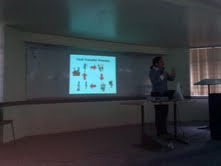Technology and Innovation
Talk “Strategicness of Technology for Business”,
by Ms MAOI ARROYO (Hybridigm)
Thurs., Jan. 7, 11.30-1,
College of Business, UP Diliman
–O–O–O–O–O–O–O–O–
http://hybridigm-consulting.com/
Hybridigm was founded by Maoi Arroyo. Ms. Arroyo was a member of the inaugural class of the Master’s in Bioscience Enterprise, a professional practice program funded by the Cambridge-MIT Institute. This program has been developed by the University of Cambridge, in association with the Harvard-MIT Division of Health Sciences and Technology (HST) and the MIT Sloan School of Management in Cambridge, Massachusetts. Spanning the worlds of science, technology and business, this one-year multidisciplinary Master’s degree provides a global perspective and unparalleled educational experience for the next generation of bioentrepreneurs.
After obtaining her Master’s degree, Ms. Arroyo worked for American, German and Asian biotech firms.
Ms. Arroyo is a recipient of a British Chevening Scholarship and obtained her first degree in Biology (BS) from the University of the Philippines.
——————–
VISION STATEMENT
To experience the fulfillment of fostering the growth of a Philippine biotechnology industry.
MISSION STATEMENT
Create a biotechnology consulting firm like no other, which provides strategic planning and expertise throughout each phase of the transition from science to enterprise by offering full support and high-value services for nascent bioentrepreneurs and existing investors.
–O–O–O–O–O–O–O–O–
- Given that the Philippines is still largely a basic-products-and-services kind of an economy, there is a need for a more highly entrepreneurial and innovative culture, to catapult the country to developed status.
- Technology can greatly help in this regard. But we need to understand the inter-meshing of technology, business (read “cash flows”), and innovation.
- Innovation means: desirability of the product or service + its possibility with technology + its viability in the marketplace.
- Thus, Innovation = Invention + Commercializability.
- There are various “stages” of innovation: There’s (1) Product innovation, (2) Process innovation, and (on the CONSUMER side) (3) BUSINESS MODEL innovation.
- Take the example of Ford (motor vehicle innovation): If Ford weren’t ‘innovative’, it would’ve simply offered or ‘invented’ a faster horse. But, no, it gave the world the MOTOR VEHICLE. So, in a sense, Ford worked on a technology-push, but at the same time, a marketplace-pull.
- Usually, true business model innovations work on the basis of: (a) Overserved Customers, and/or (b) Non-Consumers.
- Important point (about us as consumers): “We are great buyers, but we hate being sold to.” There are many implications here: one is that marketers have the challenge of marketing better (how do we design marketing programs and taglines better?).
- OBSTACLES to a truly “Innovative Spirit”:
- Internally: those organizations who wish to be innovative:
- are not as fast as they want to be;
- are not as successful as often as they’d want to be;
- are too fragmented across too many different projects;
- are not well-aligned organizationally.
- External Environment: Challenges are:
- New Competition;
- Intense, and increasing, price & cost pressure;
- Ever shrinking product life cycles;
- Increasing globalization;
- Major technology shifts.
–> which are also the principal obstacles to profitable and sustainable growth.
- REALITY: (1) Rate of success in innovation is quite low: approx. 25% (2) 90% of firms cannot maintain adequate growth to sustain above-average shareholder returns for more than a decade.
- Concretely, the PROBLEMS are:
- Time & cost overruns;
- Competing development priorities;
- Poor upfront market research;
- Failure to gather sufficient or relevant end-user input;
- Poor inter-departmental communication.
- Can YOU succeed? Yes you can! …IF you follow the 7 basic rules:
- Exert strong LEADERSHIP (in innovation strategy & decisions)
- Integrate innovation into the very lifeblood of the company
- Align innovation (to business type & vision)
- Manage the natural tension between innovation & commercialization [* Recall speaker’s funny, amusing, real, practical way of describing the differences between Biotech R&D people and Accountants 😀 😀 😀 ]
- Neutralize organizational antibodies that interfere
- Fundamental building block of innovation is a network of people AND knowledge
- Develop the right metrics and rewards for innovation.
–TO BE CONTINUED —
🙂 😉

